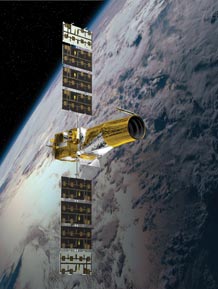
The CoRoT satellite orbits the Earth taking very precise measurements of variations in the light intensity of a very large number of stars. These are taken continually over durations as long as 150 days - this is a world first.
CoRoT discovery challenges the definition of extra-solar planet
The CoRoT satellite has discovered a planet-sized object so exotic that astronomers are unsure whether to call it a planet.
The object, named CoRoT-Exo-3b, is approximately the same size as Jupiter, but more than 20 times its mass.
It orbits a star slightly larger than the Sun every 4 and a quarter days, and passes in front of the star each time. When this occurs CoRoT observes a small dip in the star's brightness, and it is thanks to these 'transits' that the companion was detected.
Leader of the discovery team, Dr Magali Deleuil from the Laboratoire d'Astrophysique de Marseille (LAM), said, "It was a surprise to find a companion of this mass so close to its host star. CoRoT-Exo-3b is a unique object, and its exact nature is under debate. If it is a planet, CoRoT-Exo-3b would be the most massive and densest found to date - more than twice as dense as lead. Just how such a massive, close companion can form is an open question."
Dr Hans Deeg, from the Instituto de Astrofisica de Canarias (IAC) commented, "On the other hand it could also be a very low-mass brown dwarf, a ‘failed star’ which never got massive and hot enough to shine like a normal star."
Dr Suzanne Aigrain of the University of Exeter, explains why this new object is such an important find for planet hunters: "There is no clear consensus among scientists where to draw the exact boundary between planets and brown dwarfs. No object has been found before which is so close to this boundary, yet orbits its host star so rapidly. Many astronomers had started to think that such objects did not exist.”
"Of course, it could be a rare object which CoRoT found by sheer luck", comments Dr Francois Bouchy, another member of the discovery team from Institut d'Astrophysique de Paris (IAP), "but it could also be the first member of a new family of very massive planets which form around stars more massive than our Sun. There seems to be an emerging trend: more massive stars have more massive planets."
CoRoT (COnvection, ROtation and planetary Transits) is a 27-cm aperture space telescope designed to detect tiny changes in brightness from nearby stars. The instrument has two scientific objectives: the search for planets around other stars than our Sun, and the detection of stellar oscillations to study their interiors (stellar seismology). The CoRoT space mission is a co-operative mission led by the French space agency CNES, with contributions from Austria, Belgium, Germany, Spain, Brazil and the European Space Agency.
This discovery was supported by ground-based observations using a network of facilities operated by different institutes and in different countries: the telescope of Observatoire de Haute Provence (France), the European Southern Observatory telescopes at Paranal and La Silla (Chile), the Thuringia State Observatory in Tautenburg (Germany), the Canada-France-Hawaii Telescope on Mauna Kea, and a series of 1-m class telescopes: the swiss Euler Telescope at La Silla (Chile), the 1m telescope at WISE Observatory (Israel), and the 1m European Space Agency and 80cm Astrophysical Institute of the Canary Islands telescopes on Mt. Teide in Tenerife (Spain).
Date: 13 October 2008
